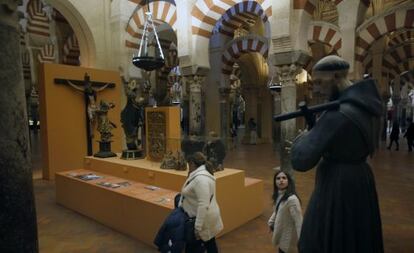The takeover of Córdoba’s Mezquita
Catholic Church accused of denying the Islamic identity of the UNESCO World Heritage site


Córdoba’s Mezquita dominates the historic center of the Andalusian city, lending its name to any number of shops and other establishments, and appearing on all sorts of street signs. Indeed, it would be fair to say the mosque, built by Abd al-Rahman I in the late eighth century during the Arab occupation of Spain, is one of the biggest draws for visitors to Córdoba and, along with the adjoining cathedral, was declared a UNESCO World Heritage Site in 1984. Little wonder then, that many of the close to 1.5 million people who enter the mosque each year are puzzled to be greeted by a sign welcoming them to “this Holy Cathedral Church.”
“I don’t understand why the mosque is full of Catholic symbols,” says Alberto, a visitor from Barcelona. “There’s nothing here about the Muslim history of the building.”
Meanwhile, Dani and María, who have traveled here from Cádiz, note that the statue of a crucified Christ and an image of Saint Teresa “seem out of place”.
I don’t understand why it is full of Catholic symbols. There’s nothing here about the Muslim history” Alberto, a visitor from Barcelona
A petition recently launched by online activism site Change.org is aiming to draw attention to what it says is a stealthy takeover of the mosque by the Catholic Church that began in 2006 when the diocese of Córdoba registered the mosque and cathedral complex in the city’s property register as a single entity.
“Over the last decade, the diocese of Córdoba has steadily filled the mosque with Catholic imagery: next to the mihrab, the niche that indicates the direction of Mecca, an enormous statue of San Juan de Ávila now stands; and this Christmas, two enormous nativity scenes were placed there, along with an exhibition of saints and virgins,” says Antonio Manuel Rodríguez, who has helped organize the petition that has been signed by almost 400,000 people to retain the mosque’s original condition.
“The Catholic Church has shown insatiable voracity, registering thousands of properties in its name,” says Antonio Manuel Rodríguez. “In this case, if the whole complex is a cathedral, then its 20,396 square meters make it bigger than St. Peter’s in the Vatican.”
The mosque was begun in 785 on the site of the basilica of San Vicente, and took nearly two centuries to complete. In 1236, after Ferdinand III reconquered Córdoba, the mosque was consecrated as a cathedral. Three hundred years later, a new cathedral was constructed within the interior of the mosque. In 1994, when UNESCO extended World Heritage status to the entire city center of Córdoba, it highlighted the importance of the “coexistence” of the mosque and the Christian cathedral, calling it “a great example of religious tolerance.” Spanish politician Federico Mayor Zaragoza, a former director general of UNESCO, has criticized the diocese of Córdoba’s management of the site: “If we don’t see some changes, I will do everything I can to uncover just what is going on here. And that could mean UNESCO declaring the site’s World Heritage status to be in danger.”
The diocese of Córdoba did not tell the Spanish government that it had registered the mosque-cathedral complex in 2006. “There was no need to do so, just as any individual can register their home,” says José Juan Jiménez Güeto, the cathedral council’s spokesman: “It does not belong to the state. It has belonged to the diocese of Córdoba since it was consecrated as a cathedral in 1236.”
But Rafael Rodríguez, the head of the regional government of Andalusia’s tourism department, accused the diocese of “taking over the mosque-cathedral complex: “It has always been managed by the diocese, but the fact that it has UNESCO World Heritage status means it also belongs to all humanity. It is everybody’s.”
The regional government of Andalusia says it was prompted to take action after Google removed the word mosque from its map of Córdoba at the end of last year. The cathedral council’s spokesman denies any involvement, admitting: “It is known around the world as a mosque.” Google has now added the word back but has not revealed who requested it to remove the term mosque from its maps.
Andalusia’s tourism department called a meeting with the cathedral council, telling it that the management of the site had to be shared with a public body: “After all, 90 percent of the use of it is related to tourism, not religion, and we need to be involved in that.”
This Christmas, two enormous nativity scenes were placed there, along with an exhibition of saints and virgins” Antonio Manuel Rodríguez, Change.org petition organizer
Between January and November of 2014, around 1.4 million people visited the mosque-cathedral complex, generating more than €9 million. The cathedral council says that 30 percent of the money is spent on charity, 25 percent on maintenance, and the rest is divided up between “cultural activities, pastoral work, and general costs.”
The regional government of Andalusia and the organizers of the Change.org petition are calling for greater transparency over how the revenue is spent. “We don’t want to put our hand in the till, but those €9 million are not generated by passing round the collecting box after mass, but charging entry to the second-biggest tourist draw in Andalusia, after the Alhambra. The site needs to be managed professionally, through a foundation, for example,” says the region’s head of tourism, Rafael Rodríguez.
José Chamizo, a priest and the former ombudsman of the regional government of Andalusia, has also joined the debate, calling on the diocese of Córdoba not to turn the mosque into “an antique shop.” He says he would also like to see Muslims be allowed to use the mosque for certain religious festivities, a suggestion the cathedral council rejects outright, saying: “Fortunately, in Cordoba, the Muslim community has three mosques at its disposal,” pointedly not including the city’s best-known mosque among them.
The city’s tourist guides have also been drawn into the conflict over the mosque’s status. The cathedral council requires guides to pass an exam. Rita Schiltz, winner of the regional government of Andalusia’s annual tourism prize in 2013, who has four decades’ experience as a guide in Córdoba behind her, is not allowed to work in the mosque. “That exam is illegal, and includes questions about catechism. I have tried on two occasions and been refused,” she says. The regional government says it intends to oblige the cathedral authorities to accept guides it has approved.
Tu suscripción se está usando en otro dispositivo
¿Quieres añadir otro usuario a tu suscripción?
Si continúas leyendo en este dispositivo, no se podrá leer en el otro.
FlechaTu suscripción se está usando en otro dispositivo y solo puedes acceder a EL PAÍS desde un dispositivo a la vez.
Si quieres compartir tu cuenta, cambia tu suscripción a la modalidad Premium, así podrás añadir otro usuario. Cada uno accederá con su propia cuenta de email, lo que os permitirá personalizar vuestra experiencia en EL PAÍS.
¿Tienes una suscripción de empresa? Accede aquí para contratar más cuentas.
En el caso de no saber quién está usando tu cuenta, te recomendamos cambiar tu contraseña aquí.
Si decides continuar compartiendo tu cuenta, este mensaje se mostrará en tu dispositivo y en el de la otra persona que está usando tu cuenta de forma indefinida, afectando a tu experiencia de lectura. Puedes consultar aquí los términos y condiciones de la suscripción digital.








































